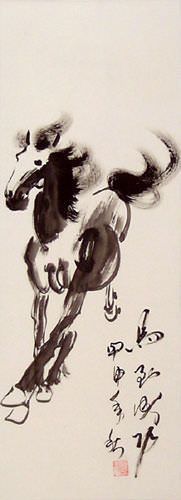
I often hear the
bridge metaphor in martial arts talk. It has a number of different meanings.
Zhang Xuexin used it to describe what he called the
bridge stance. His metaphor was a rainbow bridge, probably bamboo, which was a brilliant Chinese structural innovation of the Sung Dynasty.
The idea is that your legs are like huge bundles of bamboo stuck in the ground at angles leaning over a river. These bundles then have more and more bundles tied to them at progressively lower angels until the two sides of the bridge meet in the middle. By staggering the bundles you create many triangles in the structure and it

becomes a self supporting woven structure, which is both strong and quite flexible.
In other words, he was saying that the
two legs are a connected structure which is constantly redistributing the weight of the torso.
Luo Dexiu and the gang over at
formosaneijia are using the metaphor to mean the act of crossing over. If you are going to have a fight at a bridge and you meet your opponent in the middle, you both have equally limited space to maneuver. Step back and you are below your opponent, step side and you're in the drink.

However; if your opponent decides to cross the bridge first you can gain an advantage by attacking him just as he is exiting the bridge, at the moment where his maneuverability is limited and yours isn't.
This complex metaphor is used to talk about how we enter a fight and close the gap between us. Speed, power, technique, and the use of timing all change dramatically as the two fighters get closer and closer together. (Basically we move through this approximate progression in an instant: Kicks, jabs, stomping, slaps, hooks, throws, knees, elbows, shoulders, more throws, grappling.)
Thus the bridge is often the movement or
technique one uses
to get in closer. If you "
cross the bridge first" your technique should compensate for that moment of vulnerability just as you "
get off the bridge." For instance, someone will often step in fast faking with the back of their hand outstretch, if this is met by the opponent's hand, one can can sense the opponents intentions, direction, and power at the moment of contact and spontaneously use that information to inform the next part of their attack.

Others, like the
Blacktaoist, are, by extension, using the term
bridge to mean one's arm. If the arm is the first contact with the opponent then it needs to have extraordinarily good structure, so that it can take all the heavy traffic that is going to be traveling over it! More traffic, more power. If you have a weak bridge (that can't handle much traffic), it doesn't matter how good your
techniques are, your opponent's bridge will send more heavy traffic (o.k. how about troops then?) to dominate your side of the the bridge.


 Imagine you are a wolf, or some other predator, who is absolutely terrified. Not just passing fear, but the kind of fear that colors everything. Tree branches could fall on you at at any moment, the sun burns and dehydrates, the night freezes. Even the air you breath is frightening.
Imagine you are a wolf, or some other predator, who is absolutely terrified. Not just passing fear, but the kind of fear that colors everything. Tree branches could fall on you at at any moment, the sun burns and dehydrates, the night freezes. Even the air you breath is frightening. I'm working on some posts about fear, but they aren't finished yet.
I'm working on some posts about fear, but they aren't finished yet. The T'ai Chi Boxing
The T'ai Chi Boxing  I often hear the bridge metaphor in martial arts talk. It has a number of different meanings.
I often hear the bridge metaphor in martial arts talk. It has a number of different meanings.  becomes a self supporting woven structure, which is both strong and quite flexible.
becomes a self supporting woven structure, which is both strong and quite flexible.

 One of the biggest challenges of being a teacher is that students are always trying to get me to equivocate. For instance, I say, "Practice standing completely still for one hour early in the morning, everyday, before you eat breakfast."
One of the biggest challenges of being a teacher is that students are always trying to get me to equivocate. For instance, I say, "Practice standing completely still for one hour early in the morning, everyday, before you eat breakfast."
 subject,
subject,  In the martial arts world I've encountered three basic types of teachers, all of which are great and all of which have draw backs.
In the martial arts world I've encountered three basic types of teachers, all of which are great and all of which have draw backs. both in innovation and in the history of how each aspect of the art developed.
both in innovation and in the history of how each aspect of the art developed. toward them. I know of an old Gongfu master who worked bank security and kept a bit of metal-filings dust in his pocket to throw in peoples eyes if necessary. Better hope your blink reflex is operating if that happens. Taken to a possessed extreme, these are the bug eyes we sometimes see on crazy people.
toward them. I know of an old Gongfu master who worked bank security and kept a bit of metal-filings dust in his pocket to throw in peoples eyes if necessary. Better hope your blink reflex is operating if that happens. Taken to a possessed extreme, these are the bug eyes we sometimes see on crazy people.